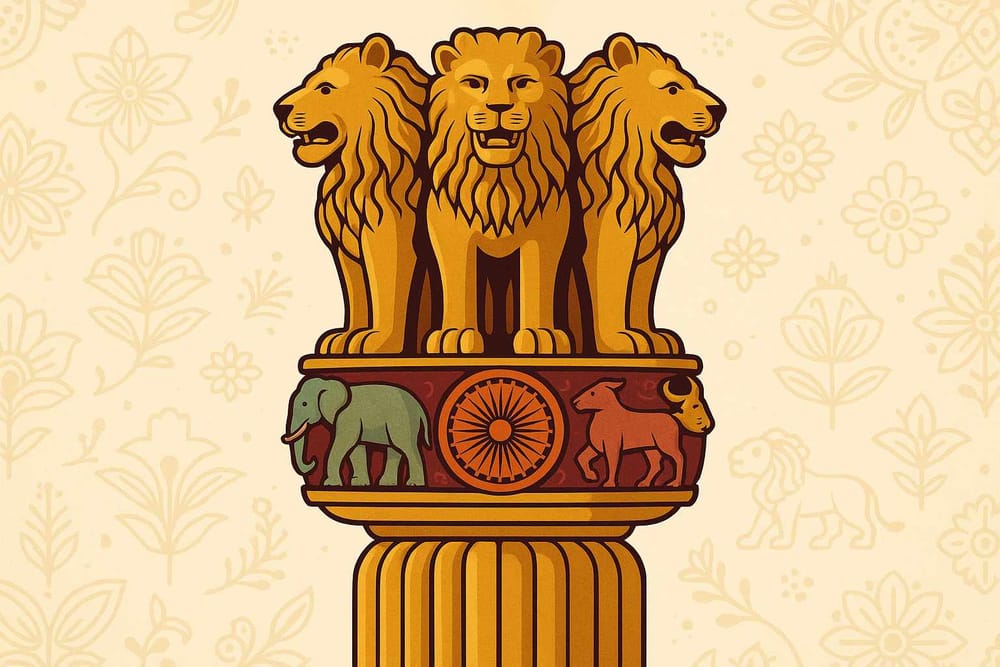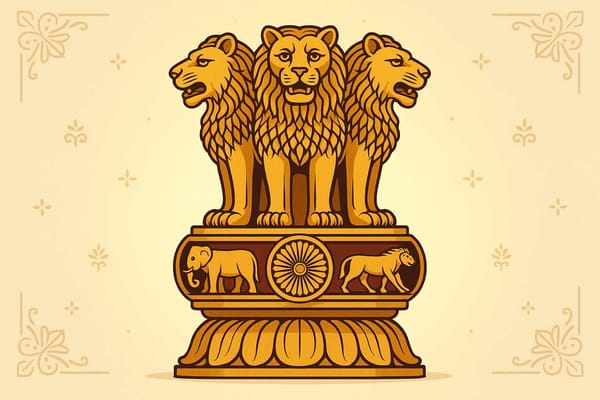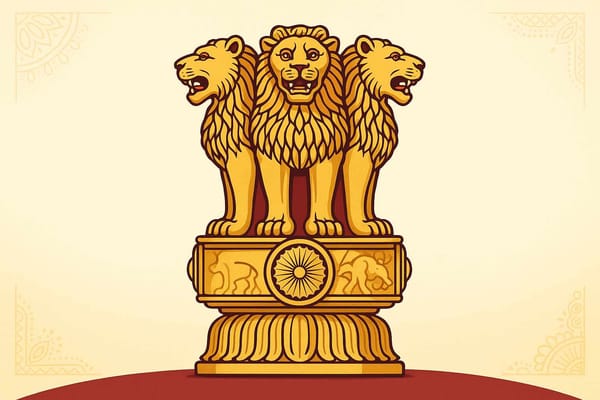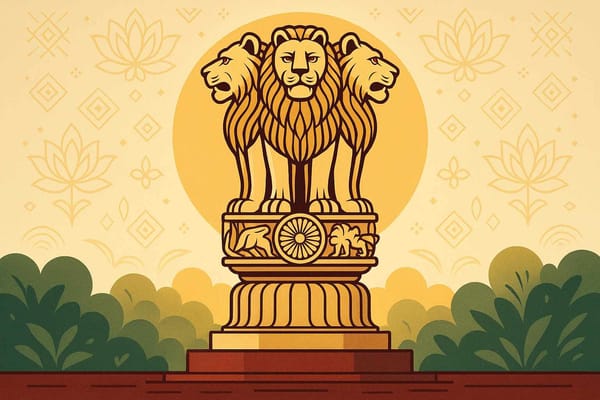
Lion Capital of Ashoka: Symbolism Explained
Have you ever looked closely at an Indian passport, a currency note, or a government seal? That majestic emblem of four lions, standing tall and proud, is something we see almost every day. It’s so familiar that we often forget to pause and wonder about its story. This isn't just a design; it's the Lion Capital of Ashoka, our national emblem, a powerful echo from our past that speaks volumes about who we are and what we stand for. It’s a symbol that carries the weight of history, the light of Dharma, and the dreams of a billion people.
Let's journey back in time, over two thousand years ago, to understand the heart of this incredible symbol. It’s a story of a great emperor, a devastating war, and a profound transformation that changed the course of Indian history forever.
From a Warrior King to a Messenger of Peace: The Story Behind the Emblem
The tale of the Lion Capital begins with one of India's most powerful rulers, Emperor Ashoka of the Mauryan dynasty. In his early years, Ashoka was a fierce conqueror. But the bloody Kalinga war, which led to immense suffering, changed him completely. Filled with remorse, Ashoka embraced Buddhism and dedicated the rest of his life to spreading the principles of Dharma (righteousness), ahimsa (non-violence), and peace.
To share his message across his vast empire, he erected magnificent pillars, and on top of one such pillar at Sarnath, he placed this masterpiece. Sarnath was not just any location; it was the sacred ground where Lord Buddha gave his very first sermon, setting the "Wheel of Dharma" in motion. The original sculpture, carved from a single block of polished sandstone, now rests safely in the Sarnath Museum, but its spirit continues to guide our nation.
Decoding the Symbolism: What Every Detail Tells Us
The Lion Capital is not just a sculpture; it is a profound philosophy carved in stone. Every element has a deep meaning, carefully chosen to convey a powerful message.
The Four Majestic Lions
At the very top stand four magnificent lions, facing the four cardinal directions. They are not roaring in anger but are depicted with open mouths, spreading the message of Dharma. This is often called the 'Simhanada' or the lion's roar of truth and wisdom, reaching every corner of the world. These lions together symbolize:
- Power, Courage, and Confidence: The lions represent the strength of a nation built on a foundation of righteousness. They remind us of the courage required to walk the path of truth and the confidence that comes from it.
- Guardians of Dharma: By facing all four directions, they act as vigilant guardians, ensuring that justice and morality prevail everywhere. They represent the universal nature of the Buddha's teachings.
The Abacus and the Wheel of Dharma
Just below the lions is a circular base called the abacus. This platform is adorned with intricate carvings that hold their own significance.
The abacus features four animals separated by wheels: a galloping horse, a majestic elephant, a strong bull, and a courageous lion. These animals are not random decorations. The horse represents speed, loyalty, and royalty. The elephant symbolizes wisdom and strength. The bull stands for hard work, fertility, and the agricultural backbone of our country. The lion, once again, signifies courage and royalty. Together, they represent a harmonious and prosperous nation moving forward with strength and wisdom.
The most important element here is the wheel, the Ashoka Chakra. This "Wheel of Law" or Dharma Chakra is at the very heart of our national identity. It represents the eternal cycle of life, truth, and moral progress. It's a constant reminder of our duty to uphold righteousness. This very chakra proudly sits at the center of our National Flag, guiding the destiny of our nation.
Below the abacus, the entire structure rests on a beautifully carved, inverted lotus. In Indian traditions, the lotus symbolizes purity, enlightenment, and the ability to rise above the mud of worldly troubles to blossom beautifully. The craftsmanship of Mauryan artisans seen here is truly remarkable, reflecting a golden age of Indian art and culture.
Why is the Lion Capital Our National Emblem? A Symbol for a New India
When India gained independence in 1947, our founding fathers looked for a symbol that would truly represent the spirit of our new, sovereign nation. They needed something that spoke of our ancient heritage while embodying our modern aspirations for a just and democratic society.
In 1950, the Lion Capital of Ashoka was officially adopted as the National Emblem of India. It was chosen because it perfectly captures the values our nation is built on—unity, peace, courage, and a commitment to Dharma. It reminds every Indian of the struggles of our freedom fighters and their dream of a nation where truth and justice would always triumph. It stands as a powerful symbol of our sovereignty and our responsibility to the world.
Understanding the deep meaning behind our national symbols helps us connect more profoundly with our roots. The symbolism woven into our heritage, much like in our vibrant festivals and rituals, tells the story of who we are.
At Bhaktilipi, we believe that these stories and symbols are timeless treasures. They are not just relics of the past but living wisdom that can guide and inspire us today. If you feel a connection to the profound messages hidden in our traditions, you’ll find a home with us.
We invite you to explore the world of devotional literature and cultural stories on Bhaktilipi.in. Let's journey together to rediscover the wisdom that has shaped our identity for centuries. Follow us on our social channels to stay connected with content that nourishes the soul.
A Timeless Legacy of Peace and Strength
The Lion Capital of Ashoka is far more than an ancient artifact. It is a timeless beacon of India’s cultural heritage and spiritual values. It’s a message from Emperor Ashoka, reminding us that true strength lies not in conquest, but in compassion and righteousness. Every time we see it, we are reminded of the ideals of justice, unity, and moral governance that form the bedrock of our nation.
So, the next time you hold a coin or see our emblem on a government building, take a moment to reflect on its incredible journey. It is a legacy that belongs to all of us—a symbol of a proud past and a hopeful future, forever roaring the message of Dharma to the world.
A passionate group of people dedicated to preserving India's knowledge of Dharma, Karma, and Bhakti for ourselves and the world 🙏.
Comments
Related in

Lion Capital of Ashoka-India's Heritage Explained
Have you ever held a coin in your hand or looked at your passport and truly seen the four lions seated majestically back-to-back? It’s a sight so familiar to us Indians, a part of our daily lives. But this isn't just a design; it's a

The Historical Significance of the Lion Capital of Ashoka: Understand its Enduring Legacy
There are some symbols that are etched into the very soul of a nation. For us in India, the Lion Capital of Ashoka is one such powerful emblem. We see it on our currency notes, on our passports, and on every official government letterhead. But have you ever paused to

The Significance of the Lion Capital of Ashoka: Explores Indian History
Have you ever paused for a moment, holding a currency note or looking at your passport, and truly looked at the four lions standing so majestically? That symbol, the Lion Capital of Ashoka, is something we see almost every day. But how often do we think about its story? It’
